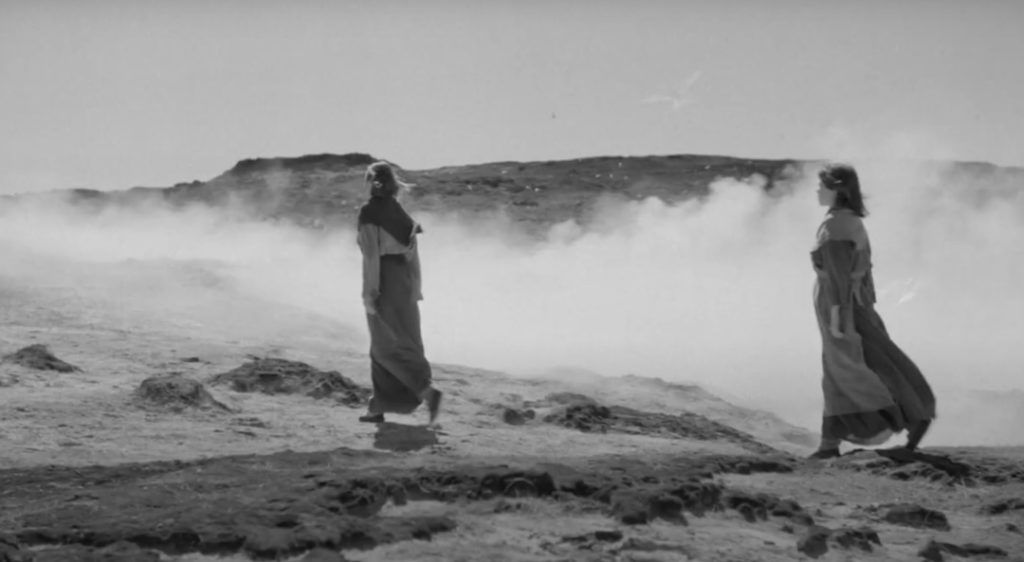
The Juniper Tree is one of those movies that’s been kicking around on my “To Watch” list for ages, but it wasn’t until last weekend that I finally saw it on Kanopy. The film, made in Iceland by American director Nietzchka Keene, was released in 1990 and is probably best known as “Björk’s first movie.” Several years ago, The Juniper Tree was restored and re-released. Since then, it’s been making the rounds on the repertory cinema circuit. In fact, if you’re in L.A. and want to see it in a theater, you can catch it at Philosophical Research Society on Saturday, February 22.
While Björk is clearly the movie’s selling point now, she’s not the only reason you should check out The Juniper Tree. It’s a stunning movie that makes good use of the landscape to tell a modern-medieval fairy tale with a Seventh Seal feel.
The film is loosely based on “The Juniper Tree,” one of the grimmest tales collected by those same Brothers Grimm who brought us such cheery children’s stories as “Hansel and Gretel” and “Little Red Riding Hood.” In the original version of “The Juniper Tree,” the evil stepmother abuses and, ultimately, decapitates, her stepson. Her brilliant scheme to cover up the crime is to first trick her young daughter into thinking she knocked off her brother’s head, then serve the dead boy for dinner. I know, it’s actually a mind-bogglingly stupid, not to mention disgusting, plan. But, it’s also a fairy tale, so the boy gets his revenge and the evil stepmother get her comeuppance. Justice is served!
Like I mentioned earlier, though, The Juniper Tree film is only loosely based on “The Juniper Tree” story. It’s not as gory, although there’s one scene that you might not want to watch while eating dinner. Fair warning. The chain of events here also isn’t as blatantly good vs. evil. There are a lot of gray areas, both figuratively and literally (it’s filmed in black and white).
Keene’s retelling of The Juniper Tree is more about witchcraft and learning to control the powers that you have. It begins with two sisters traveling far away from their home after their mother is stoned and burned for witchcraft. The elder sister plans to cast a spell to get a husband, which she does. The husband also comes with a son who can’t stand her. The younger sister, played by Björk, is a seer but is unsure how to use her power.
In the one clip of an interview with Keene, who died in 2004, that I could find, the director says that she initially cast a 13-year-old for the role of the teenager, but it didn’t quite work out. That’s when she brought in Björk, who really wasn’t that far out of her teens when the movie was filmed, several years before it was actually released. In her performance, Björk finds a good balance between childhood innocence and adult worries that makes her character, Margit, the moral center of the film.
When The Juniper Tree was filmed, in the summer of 1986, the Sugarcubes were in their infancy (Björk, however, had already played with a bunch of different bands), but, by the time the movie was released, the band were cult favorites thanks to songs like “Birthday” and “Regina.” In an interview with Barbican, cinematographer Randolph Sellars explains that the four-year gap between the production and release of the movie was because it was primarily self-financed, so Keene edited while saving money to cover the post-production costs. It went to Sundance, but the film didn’t have a distributor and, as Sellars says in the interview, “slid quietly into obscurity,” while gaining a “cult following” amongst Björk fans.
When I say there’s a Seventh Seal feel to The Juniper Tree, it turns out that’s likely intentional. Sellars mentions in the same interview that Ingmar Bergman was one of the influences. Sellars captures the rugged summer landscape in a way that’s both unsettling and magical.
There’s also a shot of the northern lights that, on its own, is worth watching The Juniper Tree. The same could be said for a scene where Margit wanders behind a waterfall and a wordless, chorus of female voices grows louder. There’s not a ton of music in the film, which makes the score all the more dramatic. (If you’re interested in that, there is an informative interview with the composer, Dr. Larry Lipkis, in Moravian College’s school paper.)
Whether or not you’re a Björk fan, The Juniper Tree is worth your time. It’s not a long movie at all. In fact, it’s well under 90 minutes. But, whether you’re interested in visuals, music or story, there’s a lot take away from it.
Liz O. is an L.A.-based writer and DJ. Read her recently published work and check out her upcoming gigs or listen to the latest Beatique Mix. Follow on Instagram for more updates.
Keep Reading:
Drop Nineteens’ New-Old Album, 1991, Is Essential Shoegaze
